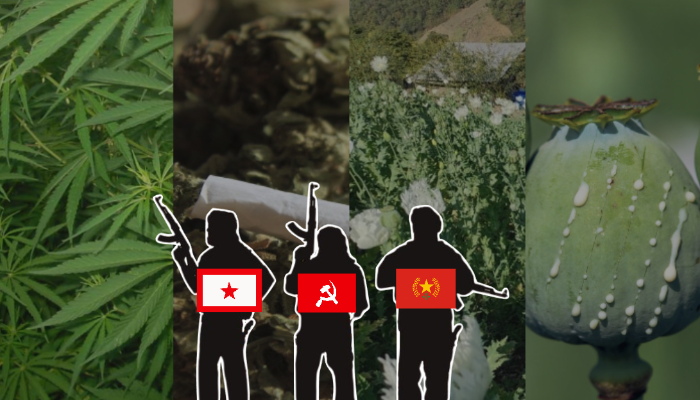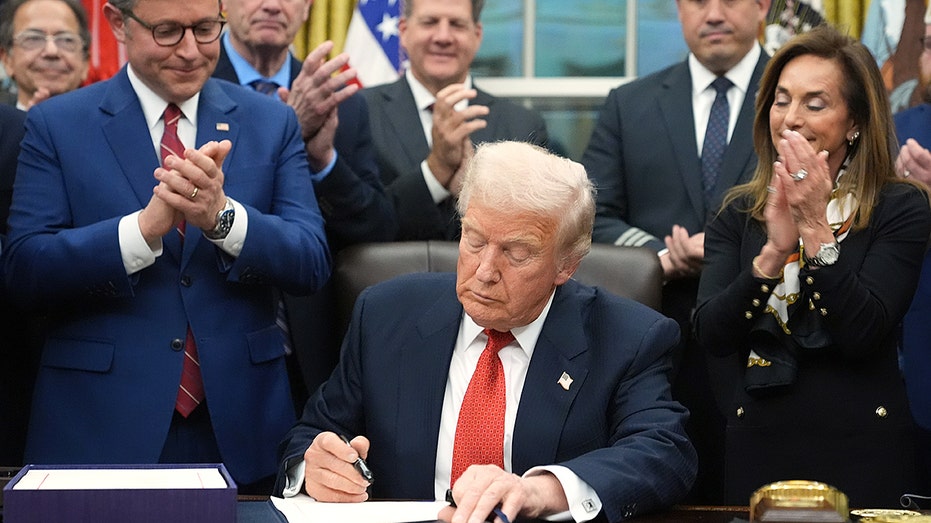Ganja in the Eastern Ghats, poppy in Manipur: How illegal cultivation of narcotics has been a major money source for Naxals and other violent armed groups
The Modi government has announced its intention to annihilate Left Wing extremism from India by 31st March 2026. The security forces, local administrations, authorities and the central government are collaborating effectively to realise the ambitious objective of a red terror-free country, yielding remarkable results. As the threat is being countered at an aggressive pace, a campaign has also been underway to dismantle the resources of these hostile elements, particularly by targeting illegal narcotics cultivation. Notably, this unlawful practice is even financing militant groups in volatile regions such as Manipur, which experienced widespread violence in 2023. Furthermore, the state’s proximity to Myanmar which is the world’s biggest source of opium greatly exacerbates the problem. Hence, while this perilous industry is prevalent in poor and underdeveloped regions with low employment opportunities, it is not confined to a single area and is pervasive from south to northeast, including the former Naxal corridor region. This not only creates an issue for the nation’s internal and national security but also poses a major environmental challenge, resulting in extensive deforestation within protected and reserved forests. However, the government is proactively working to address the epidemic of narcoterrorism. Manipur’s crucial action to eliminate illegal poppy farming On 17th November, 41 acres of illicit poppy production was wiped out in Manipur’s Tengnoupal and Kangpokpi districts. A joined team identified and uprooted the crops during the day-long operation which was conducted in the Khudei Khullen hill range under Tengnoupal Police Station. A temporary irrigation system was taken down, seven bags of fertiliser and three chemical spray pumps were destroyed as well as eighteen huts used by the producers were demolished by the forces. Officials informed that over 278 kilogrammes of opium, valued at several crores of rupees, could have been produced from the fields that were obliterated Afterward, strict inspections were conducted to prevent its replanting and to arrest the accused responsible for this activity. The move followed a series of coordinated operations that resulted in the destruction of over 500 acres of poppy plants in the state between 11th and 15th November. Poppy fields of around 436 acres were removed in the Somdal, Lamlai Chingfei, and Litan hill ranges during the drive’s largest phase in the Ukhrul district. 51 huts that the farmers utilised as makeshift dwellings and storage facilities were set on fire. The action was implemented by teams of the Assam Rifles, Central Reserve Police Force (CRPF), Manipur Police and multiple government agencies. Similarly, numerous acres of poppy crops, herbicides, pipes, spray pumps, salt bags and various farming tools along with huts were destroyed by the team in different villages. The authorities mentioned that these joint operations in the districts of Kangpokpi, Tengnoupal, Ukhrul and Senapati eradicated around 537 acres of illicit poppy farms, which would have led to 3,3583 kilogrammes of opium worth hundreds of crores. Manipur’s relentless ‘War on Drugs’ The Manipur government launched the “War on Drugs” campaign in November 2018 and the Bharatiya Janata Party outlined that the campaign had outstanding accomplishments, including the removal of 3,420 acres of unauthorised poppy crops. Moreover, over 8,000 acres of poppy plantations have been found by the authorities on government and forest areas since 2020. Destruction of poppy crops. (Source: ANI) Approximately 1,700 acres of these were destroyed in the same year. Last December, the district administration in Ukhrul, the BSF and the forest department worked together to demolish about 45 acres of illegal poppy plantations which were grown in Phungyar’s Mapithel hill range. Two people were arrested for the crime. Additionally, such action has taken place over the course of multiple months and years. The authorities announced that the government seized narcotics worth over 20 billion rupees and shut down five makeshift drug production factories in Manipur, during a period of two and a half years, reported Al Jazeera in April of last year. It also told about the destruction of 110 acres of poppy flourishing in the highlands, in 2022. According to government data, 14,315 acres of illegal poppies primarily grown in the hills was eliminated between 2017 and 2021 during the previous Bharatiya Janata Party government’s “War on Drugs” program. The state’s crucial intervention concerning this drug network was earlier underscored in a video by former chief minister N. Biren Singh in April 2024. “We have seized heroin, opium, tablets, etc. worth over Rs 60 thousand crores. Destroyed over 20 thousand hectares of poppy plantations. Number of persons arrested: 3066. Cases registered: 2461. Persons convicted under NDPS: 225. Only to save our Indian youths. We will con



The Modi government has announced its intention to annihilate Left Wing extremism from India by 31st March 2026. The security forces, local administrations, authorities and the central government are collaborating effectively to realise the ambitious objective of a red terror-free country, yielding remarkable results. As the threat is being countered at an aggressive pace, a campaign has also been underway to dismantle the resources of these hostile elements, particularly by targeting illegal narcotics cultivation.
Notably, this unlawful practice is even financing militant groups in volatile regions such as Manipur, which experienced widespread violence in 2023. Furthermore, the state’s proximity to Myanmar which is the world’s biggest source of opium greatly exacerbates the problem. Hence, while this perilous industry is prevalent in poor and underdeveloped regions with low employment opportunities, it is not confined to a single area and is pervasive from south to northeast, including the former Naxal corridor region.
This not only creates an issue for the nation’s internal and national security but also poses a major environmental challenge, resulting in extensive deforestation within protected and reserved forests. However, the government is proactively working to address the epidemic of narcoterrorism.
Manipur’s crucial action to eliminate illegal poppy farming
On 17th November, 41 acres of illicit poppy production was wiped out in Manipur’s Tengnoupal and Kangpokpi districts. A joined team identified and uprooted the crops during the day-long operation which was conducted in the Khudei Khullen hill range under Tengnoupal Police Station.
A temporary irrigation system was taken down, seven bags of fertiliser and three chemical spray pumps were destroyed as well as eighteen huts used by the producers were demolished by the forces. Officials informed that over 278 kilogrammes of opium, valued at several crores of rupees, could have been produced from the fields that were obliterated
Afterward, strict inspections were conducted to prevent its replanting and to arrest the accused responsible for this activity. The move followed a series of coordinated operations that resulted in the destruction of over 500 acres of poppy plants in the state between 11th and 15th November.
Poppy fields of around 436 acres were removed in the Somdal, Lamlai Chingfei, and Litan hill ranges during the drive’s largest phase in the Ukhrul district. 51 huts that the farmers utilised as makeshift dwellings and storage facilities were set on fire. The action was implemented by teams of the Assam Rifles, Central Reserve Police Force (CRPF), Manipur Police and multiple government agencies.
Similarly, numerous acres of poppy crops, herbicides, pipes, spray pumps, salt bags and various farming tools along with huts were destroyed by the team in different villages. The authorities mentioned that these joint operations in the districts of Kangpokpi, Tengnoupal, Ukhrul and Senapati eradicated around 537 acres of illicit poppy farms, which would have led to 3,3583 kilogrammes of opium worth hundreds of crores.
Manipur’s relentless ‘War on Drugs’
The Manipur government launched the “War on Drugs” campaign in November 2018 and the Bharatiya Janata Party outlined that the campaign had outstanding accomplishments, including the removal of 3,420 acres of unauthorised poppy crops. Moreover, over 8,000 acres of poppy plantations have been found by the authorities on government and forest areas since 2020.
Approximately 1,700 acres of these were destroyed in the same year. Last December, the district administration in Ukhrul, the BSF and the forest department worked together to demolish about 45 acres of illegal poppy plantations which were grown in Phungyar’s Mapithel hill range. Two people were arrested for the crime. Additionally, such action has taken place over the course of multiple months and years.
The authorities announced that the government seized narcotics worth over 20 billion rupees and shut down five makeshift drug production factories in Manipur, during a period of two and a half years, reported Al Jazeera in April of last year. It also told about the destruction of 110 acres of poppy flourishing in the highlands, in 2022.
According to government data, 14,315 acres of illegal poppies primarily grown in the hills was eliminated between 2017 and 2021 during the previous Bharatiya Janata Party government’s “War on Drugs” program.
The state’s crucial intervention concerning this drug network was earlier underscored in a video by former chief minister N. Biren Singh in April 2024. “We have seized heroin, opium, tablets, etc. worth over Rs 60 thousand crores. Destroyed over 20 thousand hectares of poppy plantations. Number of persons arrested: 3066. Cases registered: 2461. Persons convicted under NDPS: 225. Only to save our Indian youths. We will continue,” he wrote.
The drugs menace poses a serious threat not only to the people of Manipur and the Northeast but to every youth of our Nation.
— N. Biren Singh (@NBirenSingh) December 3, 2023
With massive public support, the War on Drugs campaign launched by the Manipur State Government has reaped many successes and brought positive changes… https://t.co/RRK5Ht7DZ7
“Manipur’s geographical proximity to the Golden Triangle (Myanmar, Laos, Thailand and Vietnam) made it a primary transit route for drug trafficking. It threatens to transform the state into a major poppy production and trafficking hub. Under the leadership of Chief Minister, N. Biren Singh, the BJP-led coalition government declared war on drugs. This will help eradicate the poppy plantation, drug trafficking, and abuse in the state,” the clip pointed out.
Notable decline in Manipur’s poppy production
According to a 2024 survey by the Manipur Remote Sensing Applications Centre (MARSAC) illegal poppy cultivation in Manipur has steadily declined over the previous four years. It was carried out between September 2023 and January 2024 and reported that the cultivation dropped from 16,632.29 acres in 2022-2023 to 11,288.07 acres in 2023-2024. Thus, it fell by 32.13% between 2022 and 2023.
Former Governor of Manipur Anusuiya Uikey also informed last year that the state eliminated 3,010 acres of illegal poppy growing. The state got rid of more than 19,135 acres of illicit poppy cultivation from 2017 to 2024.
The number of poppy fields has steadily decreased there over time as a result of this strict enforcement, demonstrating the effectiveness of the multi-level effort. This planting has long been linked to increased violence, funding of armed organisations and the ongoing ethnic tensions in Manipur, according to security and government officials.
The networks that sustain unrest in the hills frequently profit from the drug trade and its cultivation. The Assam Rifles has upheld a rigorous zero-tolerance stance against this kind of activity, taking decisive action against individuals engaged in its finance and growing.
873 Kuki-Chin persons, 1,083 Muslims, 381 Meiteis and 181 “others” were among the 2,518 arrests made in narcotics cases since 2017 in Manipur. The data was revealed by K Meghachandra, the police superintendent of the Bishnupur district and the former superintendent of narcotics and border affairs to Al Jazeera.
Officials even voiced that security forces are fostering hope for peace and stability in addition to dismantling a precarious source of income for criminal organisations, in the state’s hill districts by persistent action on poppy farms and hurting the narcocapitalism. The strong action is anticipated to continue in the upcoming days.
Narcoterrorism serves as catalyst of violence
The war on narcotics had an enormous effect on the state’s politics and it fanned the Manipur conflict. On 18th June, the Coordinating Committee on Manipur Integrity (COCOMI) declared that the main problem in the state is not the Meiti-Kuki conflict but rather the problem of Chin Kuki narco-terrorists, following a high-level conference on Manipur violence headed by Home Minister Amit Shah.
Its spokesperson, Khuraijam Athouba suggested that narco farming and smuggling is the fundamental problem that has led to the Manipur crisis. He added that it is contextually inappropriate for the central government to try to resolve the problem through negotiations between the Meitei and Kuki groups. He proposed that the actual struggle is between the Manipur government and Chin Kuki narco-terrorist organisations, in agreement with the centre.
There is a 400 kilometer stretch of the 1,640 kilometer border between India and Myanmar in Manipur where poppy planting is a major industry. The town of Moreh, characterised by its porous border was one of the locations most severely affected by the riots, in addition to Churachandpur.
A Manipur policeman and an Assam Rifles soldier were caught in Guwahati transporting prohibited yaba tablets (methamphetamine or meth) worth 200 billion rupees, in 2022. The consignment was reportedly trafficked from Moreh. This area is roughly 60 kilometres from the northernmost point of Myanmar’s Chin State.
A “very high” poppy crop density of more than six acres per square kilometre or around five football fields per square kilometre was found there by the United Nations Office on Drugs and Crime (UNODC). Similarly, Churachandpur is barely 65 kilometres from the Chin State border which is home to several poppy fields.
India took the initiative to begin fencing the 1,643 kilometer fragile border with Myanmar, in July. A source expressed, “Myanmar’s ongoing instability has further aggravated the situation, with a surge in smuggling, human trafficking, and movement of armed infiltrators. Drugs worth Rs 1,125 crore, for instance, have been seized along the border in the last six-seven months.”

The Kuki-dominated hills border Myanmar and serve as pathways for carrying drugs just as in other mountainous parts of Manipur and other states bordering Myanmar. Some northeastern states such as Mizoram, were also believed to be a key new conduit for drug trafficking from the country.
According to reports, these facilitate the smuggling of synthetic drugs and yaba tablets outside of the northeastern region. Some armed organisations in Myanmar have been shown to gain from drug smuggling. Importantly, India has repealed the Indo–Myanmar Free Movement Regime (FMR) where residents within 16 kilometre of the border had been allowed to cross without a visa, requiring simply a border pass.
Drug trade funds Manipur’s armed insurgency
There were just a few locations in Manipur where narcotics were sold in the 1990s and 1980s. According to Maibam Jogesh, co-convenor of the 3.5 Collective, a collaboration of eighteen civil society organisations fighting the drug and alcohol problem, “it is found everywhere” in the state these days. He added that their field workers located poppy planting in the hills of Manipur as long back as 2006.
“There is cultivation in the hills. Now in the valley, a lot of processing units have been established, particularly in the Thoubal and Bishnupur districts. The processing units (of brown sugar) are mainly in the Muslim areas,” mentioned K Meghachandra.
Insurgent groups require extensive sum of money for their activities. Due to the considerable push of welfare packages and strategic operations, most of these organisations are losing their base and people’s support in the region. Thus, they require a vital and continuous source of cash to support their structure and executing operations to achieve propaganda and political goals. Hence, they seek drug dealers in the Golden Triangle region for assistance.
The cadres of Chin Kuki Liberation Army (CKLA), United Tribal Liberation Army (UTLA), Kuki National Organisation (KNO) and Zomi Revolutionary Army (ZRA) among others have been implicated in drug trafficking. On 16th October 2023, the leader of a Kuki group that had agreed to a cease-fire with the Manipur government was nabbed on suspicion of dealing drugs in the state.
A few days later, security personnel detained two militants from Chaljang of Churachandpur district who belonged to CKLA. They also collected cash, 2.5 kilogrammes of opium alongside weapons and ammunition. Drug syndicates in Myanmar and militant organisations in Manipur are considered to have reached an agreement with the latter likely acting as drug couriers and intermediaries.
Therefore, these outfits which are based on ethnic ties have taken advantage of poppy farming to finance their activities. The Meitei community in the valley has accused the Kuki tribes who govern the hill regions of leveraging the money from poppy planting to arm themselves and impose territorial control. This has contributed to the cycle of violence between the two communities and increased ethnic tensions.
Furthermore, many tribal farmers have been motivated to continue their unlawful poppy production because it guarantees buyback in which the financiers or middlemen who engage in this cultivation take back the extracted opium. A top cop noted, “If farmers grow fruits and vegetables, they make Rs 200,000 a year, when they grow poppy, they make Rs 1,000,000,” according to Rising Asia Journal.
Armed groups involved in the drug trade provide protection to poppy farmers for a share of the profits. This has created a parallel economy that undermines state authority and perpetuates instability. The involvement of transnational drug cartels and cross-border smuggling networks has further complicated the situation, making Manipur a crucial node in the regional narcotics trade.
Chhattisgarh-Jharkhand: Naxals exploit Tendu leaves production to fund their activities
The collection of tendu leaves (used essentially for making beedis) has been prevalent in Chhattisgarh, which Naxalites have tried to exploit for their financial benefit. They demanded money from tendu leaf contractors and workers which not only bolstered their economic resources but also employed these funds to acquire weapons and other supplies.
On the other hand, the authorities sharpened their vigilance as the tendu leaf harvesting began in the Rajnandgaon district. Searches escalated in these areas affected by Naxal activities. The police consistently patrolled the region and contractors were instructed to swiftly notify if they encountered any coercion or extortion attempts from Naxalites.
The tendu leaves sourced from the Rajnandgaon district are well-known for their superior quality and are highly sought after across the nation which has transformed the region into an important economic center for Naxalites who managed to extract considerable amounts of money.
Superintendent of Police Mohit Garg indicated that there was a collaborative effort underway with the Forest Department for joint monitoring. Continuous communication was maintained with Tendu leaf contractors and buyers who were provided with essential guidelines. A crucial meeting was scheduled to take place soon regarding this matter to avert any extortion.
The police escalated their search operations in border and forest regions. Additionally, intelligence agencies mobilized to ensure timely information regarding any Naxalite activities and to facilitate prompt action.
Tribal hamlets of Jharkhand used for poppy farming and smuggling
Bangladeshi intruders in the Santhal Pargana region of Jharkhand affected both the demographic composition as well as the law and order situation. They were uncovered to be involved in opium cultivation in the area, utilizing local tribal communities as a facade. The product was then trafficked.
Bangladeshi smugglers frequent the impoverished areas of Santhal Pargana region, masqueraded as vendors to connect with the local populace.
These smugglers gradually persuaded villagers in the name of earning substantial profits from a limited area and they consented. Afterwards, the locals were supplied with opium seeds, fertilisers and pesticides, and it was then trafficked from India to Bangladesh. The poppy seeds resulting from opium cultivation were also used for further profits.
This trade persisted for an extended period. These operations ceased for several days when cops intensified their efforts,. However, they promptly resumed their activities after police eased their strictness. The cultivation proliferated to such an extent that satellite surveillance was carried out in 2009.
These traffickers continued to infiltrate the border into West Bengal and Jharkhand furthering their operations. Notably, opium valued at around Rs 6 crore was confiscated in Chaibasa of Jharkhand in one operation. These fields were identified in 125 villages in June 2023, in Chatra of Jharkhand.
This trade was valued at Rs 100 crore. Satellite surveillance in Jharkhand did witness some success in this region. Nevertheless, opium was produced and sold in certain areas along the border. Jharkhand BJP state president Babulal Marandi also voiced his apprehension regarding the same. He stated that this represented a plot to destroy the youth of Santhal Pargana by trapping them into drug addiction and accused Jharkhand government of negligence.
Maoists produce cannabis to support operations
While Maoists utilised the opium to support their operations in Santhal Pargana areas, they were also trying to fund their operations through illegal cannabis (Ganja) farming in the Eastern Ghats areas, hills of Southern Odisha and Northern Andhra. Ganja cultivation had expanded to nine of the eleven mandals, in the Visakhapatnam Agency (hilly and forested tracts of the district) in 2019. It was happening with the support of the outlawed Communist Party of India (Maoist).
The police stated that there was a connection between the group, ganja producers and intermediaries or smugglers since the drug had grown to be an important source of funding to the prohibited CPI(M).
The Visakha Agency which encompasses the 11 mandals is made up of approximately 6,265 square kilometre of the district’s overall 11,161 square kilometre. The Department of Prohibition and Excise conservatively estimated that the crop was widely produced over 5,000 to 7,000 acres in roughly 150 villages.
Documents that the security forces were able to retrieve clearly illustrated that the Maoists controlled the manufacture and transportation of weed. At least 1,000 pits could be accommodated on each acre. If Rs 100 was collected for each pit, the Maoists would make almost Rs 1 lakh per acre, or nearly Rs 50 crore for 5,000 acres, according to a calculation.
The average production from each plant was close to a kilogramme which translated to nearly 1,000 kilogrammes or 1 tonne per acre, according to the excise officers. Additionally, the average production were 5,000 tonnes if it took place on 5,000 acres. The yearly yield was almost 10,000 tonnes because ganja was produced twice a year.
The price ranged from Rs 7000 to Rs 15,000 per kilogramme when smuggled to cities like Hyderabad, Bengaluru, Goa and Delhi. However, the smugglers purchased from the farmers for Rs 2000 per kilogramme, leading to major proifts.
An officer asserted, “This indicates the scale of ganja business in the Visakha Agency area and why the Maoists take interest in allowing the Adivasis to grow them, despite their claim in their literature that they are against it.”
Andhra Pradesh Director General of Police Damodar Gautam Sawang reiterated in 2021 that Maoists were encouraging ganja cultivation in tribal areas of Vizag agency and along the Andhra-Odisha border (AOB) since it served as the primary source of income for them. He added that they were collecting protection money from ganja smugglers.
“Ganja cultivation is quite prevalent in the hilly areas of AOB. As Maoists are supporting the trade, enforcement agencies are struggling to put an end to cannabis cultivation and its smuggling. Coordination with police and enforcement officials of other states is crucial and can help in controlling the ganja menace. We discussed strategies to be adopted to curb the cultivation and smuggling of ganja at the meeting,” the former top cop voiced.

The Special Enforcement Bureau (SEB) destroyed ganja growing on more than 7,500 acres in the districts of East Godavari and Visakhapatnam in 2022. They destroyed ganja rated at more than 9,000 crore in Vizag Agency and noted that 75% of cannabis and ganja were grown on the Andhra-Odisha Border (AOB) and Odisha, respectively. According to them, it had been procured in more than 20 districts in Odisha and 11 mandals in the districts of Visakhapatnam and East Godavari.
Last year, Dwaraka Tirumala Rao, Director-General of Police for Andhra Pradesh, conveyed that the government formed an Anti-Narcotic Task Force (ANTF) to combat the menace. The police department would provide a toll-free number for the public’s convenience once the ANTF went into effect.
“The movement of Maoists has come down, but we have been trying to remove their roots from the state,” Rao pronounced. The former state police chief stated that the main goal of the Narcotics Taskforce was to subdue the Ganja kingpins. He assured that police had been using drones, specialised surveillance cameras, sniffer dogs and other equipments to achieve their objective.
Authorities bust drug corridor from Odisha to Gujarat, kingpin arrested
Anilkumar Pandi alias Sitaram or Raja, a fugitive kingpin who spent more than ten years creating an interstate cannabis empire that stretched from Ganjam in Odisha to several districts around Gujarat was recently apprehended by Ahmedabad Police. A joint Gujarat–Odisha Special Task Force (STF) team caught him in a major 990 kilogramme cannabis case after he turned himself up before the Odisha High Court. He was taken into custody by the Ahmedabad Crime Branch.
The 39-year-old is accused in at least 12 NDPS (Narcotic Drugs and Psychotropic Substances Act) cases in Surat, Rajkot, Junagadh, Ahmedabad and even railway jurisdictions. He is the “central spine” of Gujarat’s cannabis trade, according to police sources.
According to Ahmedabad Crime Branch Joint Commissioner of Police (JCP) Sharad Singhal, Pandi planted cannabis in Naxal-affected areas with limited law enforcement in Ganjam, a city 125 kilometres south of Puri. He operated secret godowns in Surat’s Pandesara, Udhna, Palsana and Kamrej, selling it to Ahmedabad’s Vatva and even bordering states like Madhya Pradesh, Rajasthan and Maharashtra.
Cash was transported by Odia labourers who frequently travelled between Surat and Odisha, leaving no digital trace. He employed railway networks and rented warehouses in Surat to move ganja from Odisha to several districts in Gujarat over the past ten years, including rural areas and Dindoli, Pandesara, Utaran, Udhna, Utkalnagar and Varachha.
The operation also involved his father Vrindavan Dandapani Pandi and his 32-year-old brother Sunil Pandi. Surat police had already detained the latter in 2021 for similar offences. Both his father and brother have been charged under the NDPS and PIT-NDPS (Prevention of Illicit Traffic in Narcotic Drugs and Psychotropic Substances Act).
Ten to twelve of Pandi’s properties valued at Rs 2.09 crore as well as vehicles valued at Rs 26 lakh were confiscated by Gujarat and Odisha Police. Additionally, cannabis valued at Rs 1.90 crore was collected. According to Crime Branch sources, trafficking is their family business.
NCB exposes drug trafficking networks
Illegal cannabis production transpired in the Naxalism-affected regions of Andhra Pradesh, Odisha, Jharkhand and West Bengal as well as in the challenging terrain of some of the hilly states. The contraband produced there is transported throughout the nation. The drugs from these areas makes its way to Delhi, Maharashtra, Rajasthan, Tamil Nadu and Kerala and other states. It is also trafficked across the sea to Sri Lanka.
However, various drug trafficking networks operating in different states were busted as a result of the Narcotics Control Bureau’s (NCB) intensive enforcement, in 2020. It confiscated 10,700.5 kilogram of Ganja across the nation from August to the first week of October.
1.18 kilogram of methylenedioxy-methamphetamine (MDMA), 58.5 kilogram of opium, 1,092.4 kilogram of poppy straw, 163 kilogram of hashish, 2 kilogram of cocaine and 29.7 kilogram of heroin were caught as well as 6,53,300 Tramadol tablets were captured in Rajasthan and Maharashtra, in just two months of that year.
Himachal Pradesh and Jammu and Kashmir are two of the main cannabis-growing regions and are well-known for producing high-quality charas illegally. Cannabis plants are the source of charas, commonly referred to as hashish. Rajasthan and Madhya Pradesh are the states where opium and poppy straw are traditionally trafficked. However, Jharkhand also emerged as the centre of supply for prohibited opium and poppy straw.
Narcotics finances Naxalism and terrorism
Union Home Minister Amit Shah acknowledged that the illegal drug trade represents a threat to the country, maintaining that the proceeds from this are used to fund terrorism as well as Naxalism and undermine the country’s economy.
He stated in August 2024, “Unless we demolish the entire network or chain, we cannot control the illegal trade of narcotics. It’s an international problem. In India, we need to create more awareness and fight against it. I would say even some nations have lost the battle against the illegal trade of narcotics. We need to use scientific methods in the investigation,” reported The Times of India.
Shah was speaking during the inauguration of Narcotics Control Bureau’s office in Raipur. He highlighted that drugs are not only destroying young people but also endangering national security. He added that Prime Minister Narendra Modi has decided to purge addiction by 2047, when the country celebrates “Azadi Ka Satabdi Samaroh” and that this will require a concerted effort.
Shah mentioned that synthetic narcotics are replacing natural drugs as they are accessible in small amounts but they are more expensive and dangerous. He stressed, “We need to use scientific methods in investigating drug trafficking and go to the root of the cases.”
The home minister conveyed, “In Chhattisgarh, sedative use has been reported more than the national average at 1.45%. It shares a boundary with seven states, making the situation challenging to fight the battle against narcotics and drug trafficking. West Bengal, Odisha and Andhra Pradesh have become transit routes for Ganja smuggling.”
He explained that the concern is about Chhattisgarh’s reported Ganja consumption of 4.98% which is substantially greater than the national average of 2.83%. Shah expressed, “I will again urge that investigation should be done scientifically. If a small pouch of Ganja or other such items is sold in a shop, we should find out its root – where it is produced, transported, etc. We need a bottom-to-top approach in investigation.” He added, “E-commerce platforms are being used for drug trafficking, and drones are being used to deliver drugs.”
Drug cultivation responsible for deterioration of environment, severe health problems
This issue of narcotics production extends beyond the country’s security and stability to include its environment. Soil erosion, loss of biodiversity, changes in local climate, contamination of water sources due to chemicals, and heightened risks of floods and landslides are adverse effects associated with the cultivation of these drugs.
The aforementioned video shared by former Manipur CM stated, “The drug issue was challenging and required more intensive actions. Drone footage of massive deforestation and extensive environmental damages caused by poppy plantations angered CM N Biren. During the period from March 2022 to March 2023, the campaign yielded impressive results.”
It further conveyed, “Drugs like cannabis, opium, and yaba have catastrophic environmental impacts that range from deforestation to land sinking. Poppy cultivation causes substantial harm to the environment. Mountain slopes deforested for illicit crops expose them to landslides, mudslides, and floods.”
A report by space analytics company Suhora unveiled that Manipur lost an astounding 52,000 acres of forest area in just four years between 2021 and 2025. One of the main causes of this was poppy farming, particularly in isolated highland regions which has resulted in extensive forest destruction.
The footage added, “With more public support, the war on drugs became intensified and more effective. Poppy planters were provided alternative crops and equipment by the state government.”
Manipur’s agricultural output has been impaired by the application of chemical pesticides and fertilisers, which have severely contaminated water supplies. Indigenous populations who depend on the land for their livelihoods have been disproportionately impacted by the environmental effects.
Drug addiction and associated health problems have increased in Manipur as a result of the poppy economy. Intravenous drug abuse contributes to the state’s one of the highest HIV/AIDS rates in India. Lawlessness and impunity have been perpetuated by the illegal drug trade’s influence on local institutions and undermining of governance.
Conclusion
Drug trafficking rackets, networks, accused among others have been dismantled in various regions of the country. Measures have been implemented against the unlawful cultivation of cannabis, poppy and other drugs which has historically been proven to be a significant source of narco-terrorism, whether through Maoists or other armed insurgents.
The governments, administrations and authorities have made substantial efforts to combat this threat and made considerable progress, yet it is not entirely resolved. Therefore, a concentrated effort is necessary to address this issue, not only for the security of the nation but also for the protection of our environment.















































































